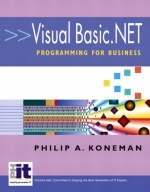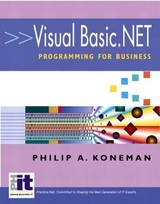
Visual Basic.Net Programming for Business
Pearson (Verlag)
978-0-13-047368-4 (ISBN)
- Titel erscheint in neuer Auflage
- Artikel merken
Basic Approach [HEPMADMIN] 27-Apr-2003 12:49 PM EST EDITFor courses in Visual BASIC.
This text examines the important programming fundamentals of both Windows desktop and ASP.NET web applications using Microsoft Visual Basic.NET, while introducing students to the important object-oriented features of that platform. Its comprehensive approach to programming utilizes integrated cases that build from chapter to chapter, and are based upon common business problems and the processes integral to solving them. A consistent four-step design methodology encourages problem-solving as students learn how to create Windows and Web applications. This text also emphasizes data storage, and important new topics such as ADO.NET, ASP.NET and XML.
Dr. Koneman manages the Certification Department at J.D. Edwards, a leading provider of integrated, Web-enabled applications designed to assist large- and medium-size companies improve business performance. In this role, Dr. Koneman manages the certification products and processes for validating the knowledge and skills of J.D. Edward's consultants and Business Partners. Prior to joining J.D. Edwards, he spent 10 years in Higher Education as an Associate Professor of Computer Information Systems at Colorado Christian University. He has taught courses in Computer Applications, Database Management, Multimedia Design, Visual Basic, and Business Ethics. Dr. Koneman has a wide professional portfolio that Includes writing, consulting, and software development. He has written for the Prentice Hall Select Series. He has worked with companies such as CertiPort, Inc. as a consultant in certification development. As the former President of Instructional Design Consultants, Inc., Dr. Koneman managed the design and development of CD-ROM instructional materials for medical technology education, and in 1995 his company was awarded the Denver Business Journal's Most Innovative New Products Award in Biotechnology for GermWare, an interactive CD-ROM for learning microbiology. Dr. Koneman received his Ph.D. from the School of Education at the University of Colorado at Denver. His research interests include computer-based learning, educational testing and measurement, and ethical issues regarding computers and technology in a post-modern society.
(NOTE: Each chapter begins with Performance Objectives and concludes with an End of Chapter Summary, Multiple-Choice Questions, True-False Questions, Short-answer Questions, Exercises, Guided Exercises, and Case Studies.)
1. Understanding Programming Concepts and Writing a Simple Visual Basic Application.
Introducing Visual Studio.NET. The .NET Framework. Do I Need a Plan? Procedural Programming. Event Driven Programming. Planning Event-Driven Programs. Working with Objects. Objects. Properties. and Methods. Steps for Planning and Creating Visual Basic.NET Applications. Using the Toolbox. Creating an Application.
2. Using Variables, Constants, and Functions in Calculations.
Using Data Stored in Controls to Perform Calculations. Using Variables in Calculations. Using Variables in Code. Variable Data Types. Naming Variables. Declaring Variables. Variable Scope. Using Constants in Calculations. Naming Constants. Declaring Constants. Obtaining User Input. The ComboBox Control. Using Functions in Calculations. Using the InputBox Function to Obtain User Input. Using the Val Function to Convert Text Entries to Numeric Data. Operator Precedence. Formatting Results for Output.
3. Processing Decisions.
Using Programming Structures. Using Decision Structures. Using the If...Then Statement. Using Flowcharts to Model Decision Statements. Using If...Then...Else Decision Statements. Nested Decision Structures. Displaying Messages for Verifying Decisions. Using an If Statement and the MsgBox function to Handle the Event for Exiting an Application. Using If Statements with Check Boxes and Radio Buttons. Radio Button and Group Box Controls. The Check Box Control. Using Decision Statements for Data Validation. Checking for a Required Value. Checking for Numeric Values. Checking for Required Data. Using If Statements with Text Strings. Comparing Text Strings. Using the UCase and LCase Functions with Text Strings. Using Logical Operators with If Statements. Using the Select Case Decision Statement. Using Select...Case Statements. Using a Select...Case Statement with Radio Buttons.
4. Using Looping Structures and Lists.
Introducing Repetition Structures. Using For...Next Statements. Displaying the Results of a Repetition Statement. Incrementing and Decrementing the Counter Variable. Endless Loops. Using Do...Loop Statements. Repeating Statements in a Do...Loop While a Condition Is True. Repeating Statements in a Do...Loop Until a Condition Is True. Exiting a Do...Loop Before a Condition is True. Working with Lists. Using the Windows Forms ListBox Control. Selecting Items in a List Using the ListBox Control for Displaying Formatted Lists. Using the For...Each...Next Statement.
5. File Access, Dialog Boxes, Error Handling, and Menus.
Data File Basics. Sequential File Access. Reading and Writing Data by Using Sequential File Access. Random File Access. Creating a User-Defined Data Type Record Structure. Declaring a Structure Variable. Opening a Random Access File. Reading Records from a Random Access File. Writing Records to a Random Access File. Processing I/O Errors by Using Exceptions. Using the Try...Catch...Finally Statement to Handle I/O Exceptions. Adding Common Dialog Boxes to Windows Forms. Using the OpenFileDialog Control. Using the SaveFileDialog Control. Using the FontDialog Control. Exceptions and Common Dialog Controls. Using the RichTextBox Control for Reading and Writing Formatted Text. Changing Font Attributes in a RichTextBox Control. Adding Menus to Windows Forms. Creating and Adding Menus to Windows Forms. Adding a MainMenu object to a form. Using the MainMenu Control. Writing Code to Handle Menu-Item Click Events. Adding a Context Menu to a Form.
6. Connecting to Databases With ADO.NET.
Database Concepts. Introducing ADO.NET. ADO.NET and Disconnected Data. ADO.NET and XML. Managed Providers. Creating and Generating a Dataset. Creating a Dataset by Using the Server Explorer. Filling a Dataset. Using the DataGrid Control. Changing Data in a DataGrid. Binding Controls to a Database.
7. Using Sub Procedures, Function Procedures, and Modules.
Procedures. Sub procedures and Function Procedures. Using Sub Procedures. Declaring a Sub Procedure. Determining the Accessibility of a Sub Procedure. Creating User-Defined Procedures. Calling a Sub procedure. Passing Arguments to Sub Procedures. Using a Sub Procedure to Perform Data Validation. Using Function Procedures. Intrinsic Function Procedures. Creating User-Defined Function Procedures. Passing Arguments ByVal and ByRef. Organizing Procedures by Using the #Region Statement. Using Modules and Multiple Forms in Windows Applications.
8. Using Arrays, Structures, and Collections.
Using Arrays. Declaring a Single-Dimension Array. Adding Data to an Array at Run Time. Declaring a Two-dimensional Array. Using Dynamic Arrays. Populating an Array by Reading a Disk File. Using Structures with Arrays. Declaring Structures. Declaring Structure Variables. Using an ArrayList to Create a Collection.
9. Object Orienting Programming with Visual Basic.NET.
Object-Oriented Programming. Objects and Classes. Object Properties and Methods. Encapsulation and Abstraction. Using Classes. Inheritance and Polymorphism. Creating Classes. Using Fields and Properties to Add Information to Objects. Storing Information in Objects by Using Fields. Storing Information in Objects by Using Properties. Using Fields versus Properties to Store Information in an Object. Class Methods. Creating and Calling Class Methods. Using Inheritance to Create a Derived Class. Overriding Methods.
10. Creating Distributed Web Applications by Using ASP.NET.
Creating Distributed Web Applications by Using ASP.NET Why Use ASP.NET? ASP.NET System Requirements. Web Design Basics: Designing Web Pages by Using HTML. Adding Interactivity to Web Pages by Using ASP.NET. Creating an ASP.NET Web Forms Project. The Web Forms Design Interface. Using Controls. Adding Web Server Controls to a Web Forms Project. Validating Data in Web Forms Projects. Validation Controls. Using ADO.NET Data Access Objects in Web Forms.
11. XML and ADO.NET.
Why Use XML? Markup Languages. Characteristics of XML. Creating XML Files by Using the XML Designer. Adding an XML File to a Project. Validating XML Data. Saving XML Data to a File. Creating an Application that Reads Data from an XML File. Creating an Application that Writes Data to an XML File. XML Schemas. XML Elements, Attributes, and Types. Naming Conventions for Elements and Attributes. Creating Schemas. Creating an XML Schema from an XML File. Creating a DataSet Schema by Using the XML Designer. Creating Relationships in XML Schemas.
12. Graphics, Printing, and Reporting with Crystal Reports.
Displaying Graphics in Applications. Using Vector Graphics in Applications. Using Raster Graphics in Applications. Using the Visual Studio.NET Image Editor. Displaying Bitmap Images in Windows Applications. Displaying Bitmap Images in Web Forms Applications. Previewing and Printing Text by Using the PrintPreviewDialog and PrintDialog Controls. Reporting and Printing Information by Using Crystal Reports. Creating a Report by Using the Report Expert. Displaying a Report.
Appendix A: Packaging and Deploying Visual Basic.NET Applications.
Installing .NET Framework Components. The Windows Installer and Setup Projects. Creating Setup and Deployment Projects. Creating a Setup and Deployment Project by Using the Windows Installer for a Windows Application. Creating a Setup and Deployment Project by Using the Windows Installer for a Web Forms Application.
Appendix B: Numeric Data Types and Type Conversions.
Using the Option Strict Statement. Widening and Narrowing Conversions. Widening Conversions. Narrowing Conversions. Option Strict and Implicit and Explicit Conversions.
Reference Guide.
Glossary.
| Erscheint lt. Verlag | 20.3.2003 |
|---|---|
| Sprache | englisch |
| Maße | 215 x 274 mm |
| Gewicht | 1353 g |
| Themenwelt | Mathematik / Informatik ► Informatik ► Programmiersprachen / -werkzeuge |
| Informatik ► Software Entwicklung ► Objektorientierung | |
| ISBN-10 | 0-13-047368-5 / 0130473685 |
| ISBN-13 | 978-0-13-047368-4 / 9780130473684 |
| Zustand | Neuware |
| Informationen gemäß Produktsicherheitsverordnung (GPSR) | |
| Haben Sie eine Frage zum Produkt? |
aus dem Bereich



